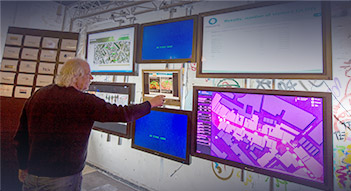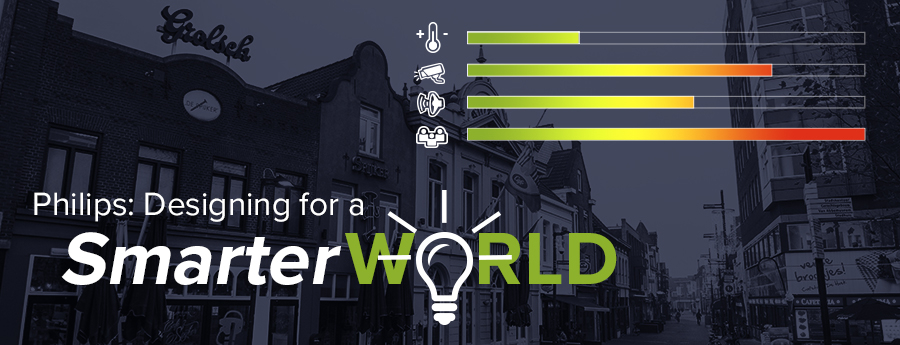Philips: Designing for a Smarter World
HANGING OUT WITH THE POLICE ON A SATURDAY NIGHT. Talking to bartenders and cafe owners. Capturing feedback from emergency medical teams, students, residents and city officials. It’s all part of the Stratumseind 2.0 project, an innovative new approach to product design, demonstrated by Philips Design, the in-house design group of Koninklijke Philips N.V.
Stratumseind, known as the party street in Eindhoven, the Netherlands, is home to nearly 60 restaurants and bars. The area attracts tens of thousands of visitors per night on weekends – most between the ages of 16 and 25. In recent years, Stratumseind’s reputation has been sullied by aggressive patrons and escalating crime. Hoping to create a safer environment for its residents, the municipality of Eindhoven teamed with the Intelligent Lighting Institute at Eindhoven University of Technology and Philips in late 2013. This partnership became part of a broader Internet of Things living lab experiment to study the impact of environmental factors, including lighting, sound and scent on crowd behavior.
The Stratumseind project exemplifies the 21st Century way of embracing innovation, fueled by the widespread growth of the Internet of Things.
Philips outfitted the 225-meter-long strasse with 25 streetlights, equipped with controllable RBG light bulbs. The lights are live-monitored by an operator who can adjust, point by point, elements such as light density and color, to emit a “cozy” atmosphere, quell a brawl outside a bar or disperse a crowd in an emergency situation. It’s a digital development approach embedded with a rapid innovation process and real-life market testing, said Ton Borsboom, Senior Director at Philips Design, during a panel discussion at the Smart Cities Expo in Barcelona last fall.
The Stratumseind project exemplifies the 21st Century way of embracing innovation, fueled by the widespread growth of the Internet of Things. OEMs like Philips must look beyond incremental product or technology improvements and design a product/service solution model to address real-world issues. They must work within an extended value chain where analytics, process optimization, collabroative product and program design and customer service experiences reign supreme.
Designing an Experience
The effort to create more meaningful, people-centric solutions like those deployed on Stratumseind is directly tied to changing market dynamics, said Borsboom. Previously, creating value at traditional product companies hinged on identifying “enduring customer needs and manufacturing well-engineered solutions,” and competitive gains resulted from “feature-versus-feature warfare,” wrote Gordon Hui, Director of Business Design and Strategy at Smart Design, in his Harvard Business Review article, How the Internet of Things Changes Business Models.  Now, in a connected world, the source of customer value has shifted downstream, “toward the services and information that surround the product,” said Niraj Dawar, author of the recently released book, “Tilt: Shifting Your Strategy from Products to Customers.”
Now, in a connected world, the source of customer value has shifted downstream, “toward the services and information that surround the product,” said Niraj Dawar, author of the recently released book, “Tilt: Shifting Your Strategy from Products to Customers.”
Philips’s Borsboom likens this evolution in product design philosophy to the approach of software designers. “Like in software, the approach to solution development is iterative,” he said. “Meaning, you get a basic solution out that delivers value and then continue to innovate the product based on fresh learning to Version 1 to Version 1.1 to Version 2, and so on.”
Shifting the Paradigm
To be successful in this new product/service solutions-focused economy, members of the electronics supply chain must change the way they innovate. “We have to design for ecosystems. We realize that networks and partners are not independent entities anymore, and it’s not only about creating efficient and effective technology,” said Borsboom. “Yes, we want technology that’s effective and efficient, but we also want to create technology that has meaning for the people in the cities we work in.”
Supporting a services-solutions-based approach also requires OEMs to shift beyond “normal” supply chain strategies, Borsboom said. At Philips, this meant embracing a Design for eXcellence (DfX) methodology in which all aspects of the design that are relevant to the total product lifecycle are assessed. “Each product is scrutinized through a series of assessments: how it will impact on the value chain, benefit the consumer, outperform the competition, be sensitive to the environment, prove financially astute and add to the competitiveness of the company,” wrote Philip’s Chief Procurement Officer Frederick Spalcke in a blog last year.
Efforts like Stratumseind not only represent a departure from the way traditional technology companies have worked, but also set the bar for how companies in the future will invest in, develop, source, make, bundle and sell products.
This collaborative approach is a cornerstone of Spalcke’s vision of procurement as the “heart of innovation” at Philips. Spalcke described his team’s critical role in the product development process: “instead of assessing products and partners after key decisions are made, procurement executives are there at the beginning. Not to ‘squeeze’ suppliers, but to energize them, to drive performance and inspire innovation.”
Philips also hosts “Global Supplier Conventions” to enable senior Philips executives to meet with strategic partners, analyze business opportunities and outline long-term goals and challenges. “This is how Philips ensures procurement is as innovative, strategic and entrepreneurial as other elements of the business,” Spalcke wrote.
The Strasse Not Taken
Efforts like Stratumseind not only represent a departure from the way traditional technology companies have worked, but also set the bar for how companies in the future will invest in, develop, source, make, bundle and sell products.
“We need to think about long-term relationships where service may be central instead of product and technology,” Borsboom said. Still, he added, “businesses still need to develop a position for themselves as the preferred partner. Therefore, the development of technologies that have unique qualities remains important in creating a competive advantage. I believe the ecosystem needs to be open and allow for many different players to participate and innovate. In this way the natural process of competition and innovation can take place, providing the best solution for the users with best performance and cost.”
Related Resources:
- White Paper: Realizing the Potential of Innovation
- Video: Philips Design Hangout: Composing Light for Urban Spaces
- Video: IoT & Smart Cities – Living Lab
- Article: Walking The Walk: Putting Design at the Heart of Business
- IDC Futurescape: The Rise of Product-as-a-Service in Manufacturing and Some of the Technology Impacts
